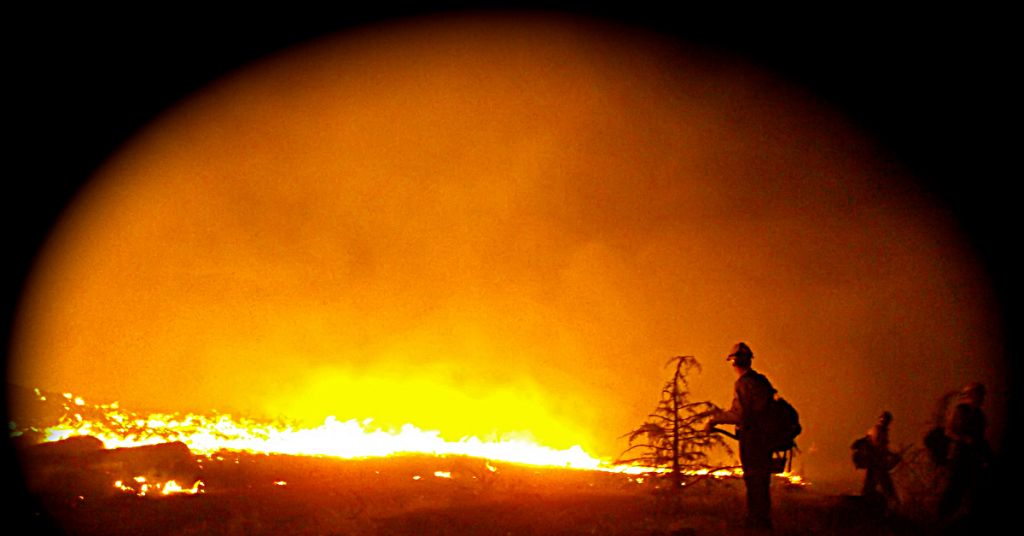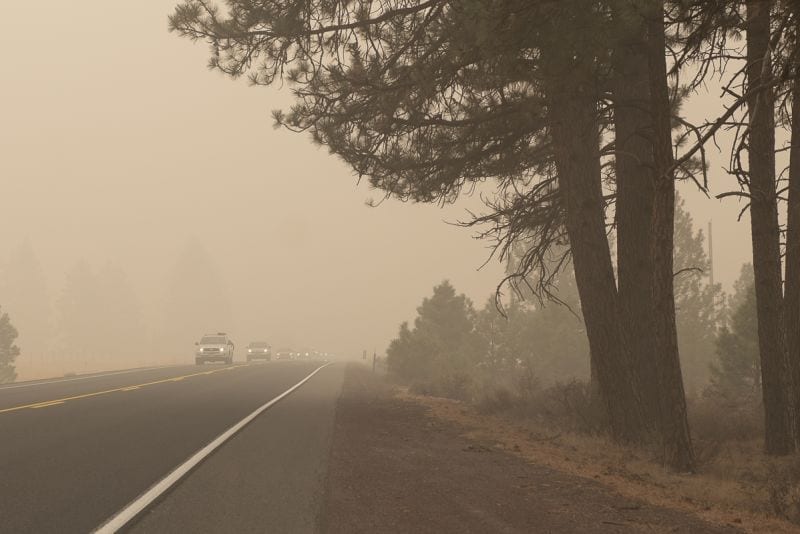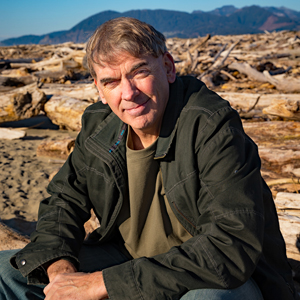More than half the forest tribes set aside for protection as part of a Cap-and-Trade program have been destroyed by fire


Imperiled trees, imperiled program: Bureau of Land Management firefighters have extensive experience on Warm Springs Reservation. Photo by Seth Macaldy/BLM Oregon
By Michael Kohn, The Bulletin. January 21, 2021. Five years ago the Confederated Tribes of Warm Springs set aside 24,000 acres of forestland for a project to sequester carbon and reduce greenhouse gases. Last summer more than half of that forest went up in smoke in the devastating Lionshead Fire.
Now tribes, which earned millions of dollars from the California Air Resources Board for the project, are hard at work assessing just how much was lost. Bobby Brunoe, general manager for the tribe’s Branch of Natural Resources, so far calculates that 15,000 acres of the project area were lost in the fire. Overall, the Lionshead Fire burned 204,000 acres, of which 96,000 acres are on the Warm Springs Indian Reservation.
Warm Springs, located 70 miles north of Bend, sells carbon credits earned through California’s Cap-and-Trade Program, by protecting its forests so they can continue to capture carbon. The program is a market-based form of regulation that sets an upper limit, or “cap,” on carbon emissions produced by companies in California.
The carbon offset projects can be located outside of California, a policy that opened the door to participation by Warm Springs. Around the country, there are 136 forest offset projects.
According to the agreement, Warm Springs will maintain and build carbon stands within its project area for 100 years. At Warm Springs, the area considered for protection was zoned as “conditional use,” a designation that allowed the tribes to log it if they so desired, although it had not been logged before.
Entering the Cap-and-Trade Program was a financial incentive to keep the forest intact and increase its carbon intake capacity. But wildfires like Lionshead throw a wrench in those intentions as the burned trees reverse carbon sequestration, sending carbon into the atmosphere.
Buffer pool protection
The California program is protected from wildfire events through its “buffer pool” of carbon credits, which are available to use in case forest carbon is lost through wildfire or other natural disasters. Each forest project contributes 10-20% of its total credits into the buffer account, which acts as a sort of insurance.
The project area on Warm Springs that burned, known as ARC260, is located on the east side of Mount Jefferson. The area will be evaluated for damage, said Brunoe, as not all areas of a forest burn the same—parts of a forest may have a light or heavy burn, or no burn at all.
In addition, a burned area is not necessarily out of the carbon project as a standing snag can still be counted as carbon.
The verified estimate of current carbon stocks must be completed by a third party within 23 months, according to the California Air Resources Board.
Much of the area where ARC260 is located is currently inaccessible due to deep snow, so research is expected to start in earnest in spring.
“The extent and severity of the fire impact to the Warm Springs carbon project remains unknown and will be under evaluation for the next year and a half, involving detailed forest inventories and modeling,” said Brunoe.
Once the evaluation of the forest damage is complete, a determination will be made on how much to reduce the buffer pool.
Scientists worried
Some scientists have expressed concern that the buffer pool is not sufficiently protected against fire risks over the 100-year period, and hold up Warm Springs as an example.
“The fact that the Warm Springs project has burned twice in a decade is a perfect example of the problem,” said Danny Cullenward, lecturer at Stanford Law School and policy director of CarbonPlan, a nonprofit that independently analyzes carbon removal opportunities based on science and data. “There is no way the protocol’s buffer pool holds up if that pattern is common in the program.”


Lasting impact: Sparked by lightning on August 16, 2020, smoke from the Lionshead Fire spread across the Warm Springs Indian Reservation well into September when this photo was taken along U.S. Route 26. Photo by Jurgen Hess
The wildfire in 2020 wasn’t the first time the project area burned. When the project was in the set-up stage, a wildfire burned around 2,000 acres of forest within the project boundaries, said Don Sampson, who helped arrange the agreement when he was chief executive of Warm Springs Ventures, the tribe’s economic arm. Sampson worked for ventures from 2013 to 2016.
When the project was in its early stages, said Sampson, a series of independent analyses took place to verify the amount and value of carbon that could be sequestered and offset.
The entire process took 3½ years to complete, longer than first anticipated due to some setbacks, including a wildfire that burned around 2,000 acres of the forest. The fire contributed to the delay in setting up the project.
“They had to reassess the burned areas and how they would regenerate,” said Sampson.
Carbon credits
When the preparation work was complete, the California Air Resources Board issued Warm Springs 2.15 million carbon offset credits. The offsets represented 2.15 million metric tons of verified greenhouse gas emission reductions.
Annual growth within the project boundary can be converted to additional carbon offsets that the tribes can sell. To date, more than 2.6 million Air Resources Board carbon offset credits have been issued to Warm Springs.
“There are about 20 projects in the range of 1 million to 5 million offset credits upfront, and a handful that get as big as almost 15 million,” said Cullenward. “I would say Warm Springs is one of the large projects but not atypically large nor on the extreme end of the size distribution.”
How are the offset credits used? In 2018, the tribes announced they had contracted with a third party to sell the credits over several years and that those credits would “provide revenue in the tens of millions of dollars for tribal operations, improved forest management and economic development initiatives.”
The tribes declined to confirm the specific amount received from the agreement.
‘Much-needed revenue’
Sampson said the tribes set aside some of the funds for forest thinning and forest health projects, to prevent wildfire and tree disease.
“Overall it brought in much-needed revenue,” he said. “That was the biggest revenue source they had for quite a few years.”
Funds were also set aside for a cannabis project. That project stalled during Sampson’s tenure at Warm Springs but was later revived into a hemp project, which received federal approval last year.
The decision to enter the program was timely, as it coincided with the winding down of the local sawmill, Warm Springs Forest Products Industries, which was struggling to turn a profit due to a lack of large logs.
The program was also consistent with the tribe’s policy on generating revenue through environmentally conscious ventures.
“Rather than take an extractive approach and cutting timber and selling logs off the reservation, (Tribal Council) wanted to transition to one that was more conservation-based and still make revenue for the tribe,” said Sampson. “So from that point of view, it was a successful project.”
Columbia Insight is publishing this story as part of the AP StoryShare program, which allows newsrooms and publishing partners to republish each other’s stories and photos.
READ MORE INDIGENOUS ISSUES STORIES.


The Collins Foundation is a supporter of Columbia Insight’s Indigenous Issues series.






